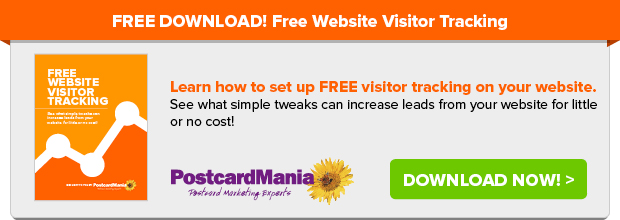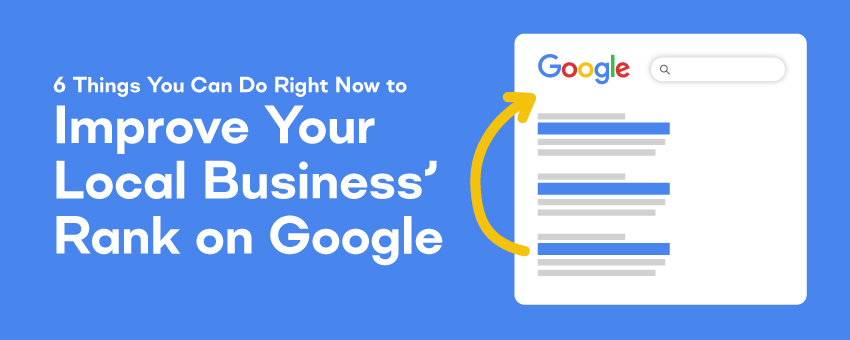6 Things You Can Do Right Now to Improve Your Local Business’ Rank on Google
Updated on January 6, 2022If you search Google for an “SEO Guide” you’re going to get a list of websites from companies that ONLY do Search Engine Optimization. So why listen to a postcard provider about how to optimize your website for search engines?
Because we’re not just a postcard company — we specialize in small business marketing. While those big-shot websites might be great for companies with a dedicated marketing staff that can pay attention to all of the meticulous details, you’re likely reading this as a small operation. Maybe even a one-person team.
I always aim to give out actionable advice that small business owners can implement to make an immediate impact on their business. So, to write this guide I worked with PostcardMania’s SEO staff and selected only the most effective SEO practices, based on our common SEO website audits, that will help boost your website’s organic rankings (organic = unpaid placement within a search engine’s results) quickly.
HOWEVER — please note that SEO is not a “set it and forget it” operation. Normally to see substantial results, you need to be continuously optimizing your website for 6 months or more. The longer and more consistent, the better! Hiring a company for local search engine optimization is not a bad idea. But here are 6 things you can do yourself right now to start improving your rankings!
1. Claim and Optimize Your Google Business Profile so Local Consumers Can Find You Easily
Having a Google Business Profile is a necessity in today’s digitally driven world. Optimizing it is THE most powerful tool you have as a business owner to manage your online presence.
A Google Business Profile is the business information you see pop up when you search for something local, or for a specific business.
When you look up a kind of business in your location, it’s shown in what we call the “map pack” which is a group of businesses that match your search.
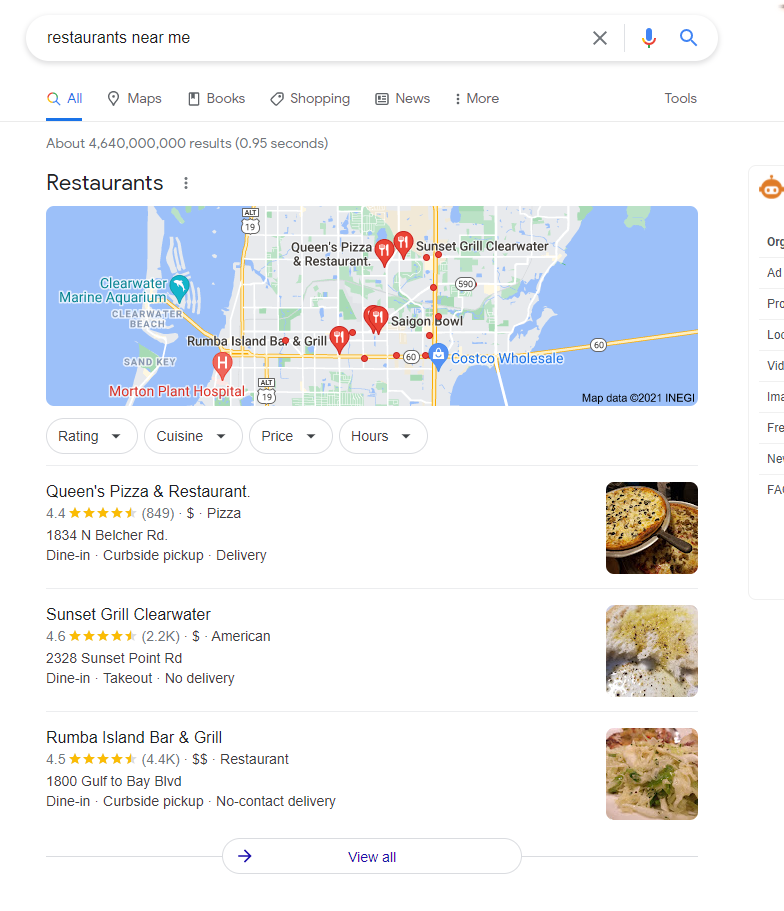
If you search for a specific business, it shows up as a box to the right of your Google search engine results page and is also the business information that comes up on Google Maps (which we refer to as the Local SEO Pack). This is PostcardMania’s Google Business Profile:
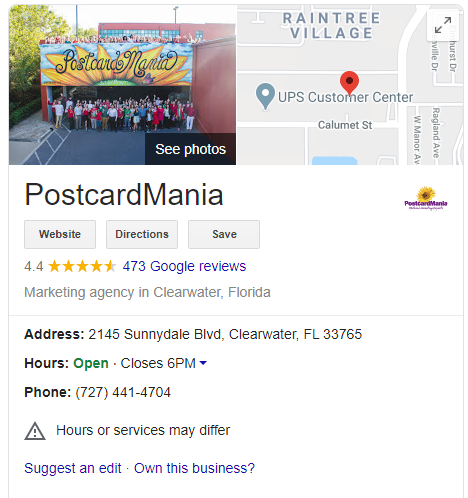
Claiming Your Google Business Profile
Just because you have a business doesn’t mean you have a Google Business Profile.
If a Google Business Profile does exist for your business, it doesn’t mean you already own it. If you Google your company name and see that a Google Business Profile exists, you have to claim ownership of it and verify that you do, in fact, own this business before you can make any edits.
First, check if a Google Business Profile exists for your business by doing the following:
First, find your profile by either Googling your company name and location and clicking on “Own this business?” on the profile. Or, visit Google’s official business search page, sign in to your Google account (make one if you don’t have one), and type in the name and address of your business to see if it comes up.
If you can’t find a profile for your business, you can create one by following these steps.
Once your Google Business Profile is claimed and verified, you can start optimizing it!
Optimizing Your Google Business Profile
Once you’re running your Google Business Profile, it’s important to optimize it so that local consumers looking for businesses in your industry can find you.
Optimize your Google Business Profile with all the information you can possibly fit, including:
- Relevant business categories and subcategories
- Your full address, business name, and phone number(s)
- Business hours (plus continuously updating for any special holiday hours)
- An engaging business description
- Eye-catching photos (I always recommend including at least three interior and exterior photos, regardless of location )
- Google Posts about new offers, services, or business updates (I always recommend postings weekly Google Business Profile posts)
- Services or products if applicable (not every business type is able to add these)
Although it isn’t a huge part of SEO, remember to monitor and respond to customer Google Reviews, even if it’s just a quick thank you! This shows you’re a highly engaged business owner, which sends a positive signal to Google but is also something potential customers want to see.
Once you’ve implemented the rest of this guide to optimize your website, read this ultimate guide on how to optimize your Google Business Profile listing. It contains minute details that will make a huge difference in the end!
2. Creating and Optimizing Business Citations for Local SEO
Outside of managing your Google Business Profile and Google Reviews, the next most important online reputation management step for SEO is making sure you’re optimizing your business listings, better known in the SEO world as citations.
Citations are online business review listings like Yelp, Angi (formerly Angie’s List), YellowPages, etc. There are hundreds of widely-used business citations, so it’s important to make sure you’re listed on all of the top ones. This helps search engines understand who you are and what you’re relevant for. The more quality listings you have, the higher your website will be ranked on Google and other search engines.
It’s important to make sure your business is listed on all of the top general directory websites — here’s a list of the top 50 local citations for 2021.
In addition, any relevant niche listings will help you stand out in your industry’s searches. For example, if you’re a medical professional, you’d want to be on HealthGrades, Opencare, and ZocDoc. If you’re a lawyer, you want to be on Super Lawyers, Justia, and Avvo.
If you’re unsure of your niche citation opportunities, search for what a potential customer would! Something like “best lawyer near me”, “best landscaping service (your town name)”, etc. Explore the search results to find out which ones are local businesses and which ones are national directory websites.
PRO TIP: Make sure your business name, address, and phone number are EXACTLY the same everywhere you’re listed online. Don’t have variations like:
- Clearwater LawnCare
- Clearwater Lawncare, LLC
- Clearwater Lawn Care
As Google will recognize these as different companies and hurt your overall organic ranking.
After you’ve completed managing your online presence, it’s time to focus inward on your website.
3. Optimizing Website Copy for Search Engines
Once your Google Business Profile presence is all taken care of, you need to make sure that your website is easily readable and scannable for both users and search engine bots. A commonly overlooked SEO step is ensuring that content is easy to read and scan over.
Just because your page is filled with quality content doesn’t mean that it’s getting read. When someone looks at the page, they should be able to quickly locate what they’re looking for.
For example, take a look at this real estate investors about page. Can you immediately tell what the long paragraphs are about?
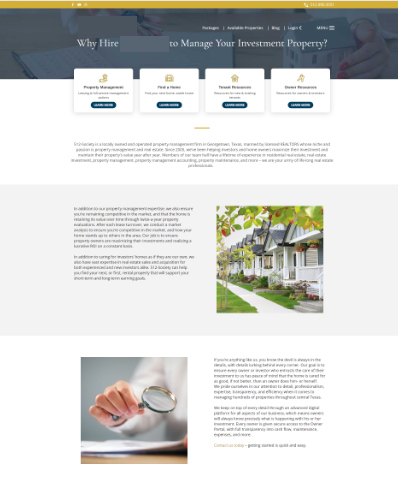
Probably not, without reading them, which is bad for both consumer engagement and SEO. Use headings and subheadings whenever you can to identify pieces of information like this:
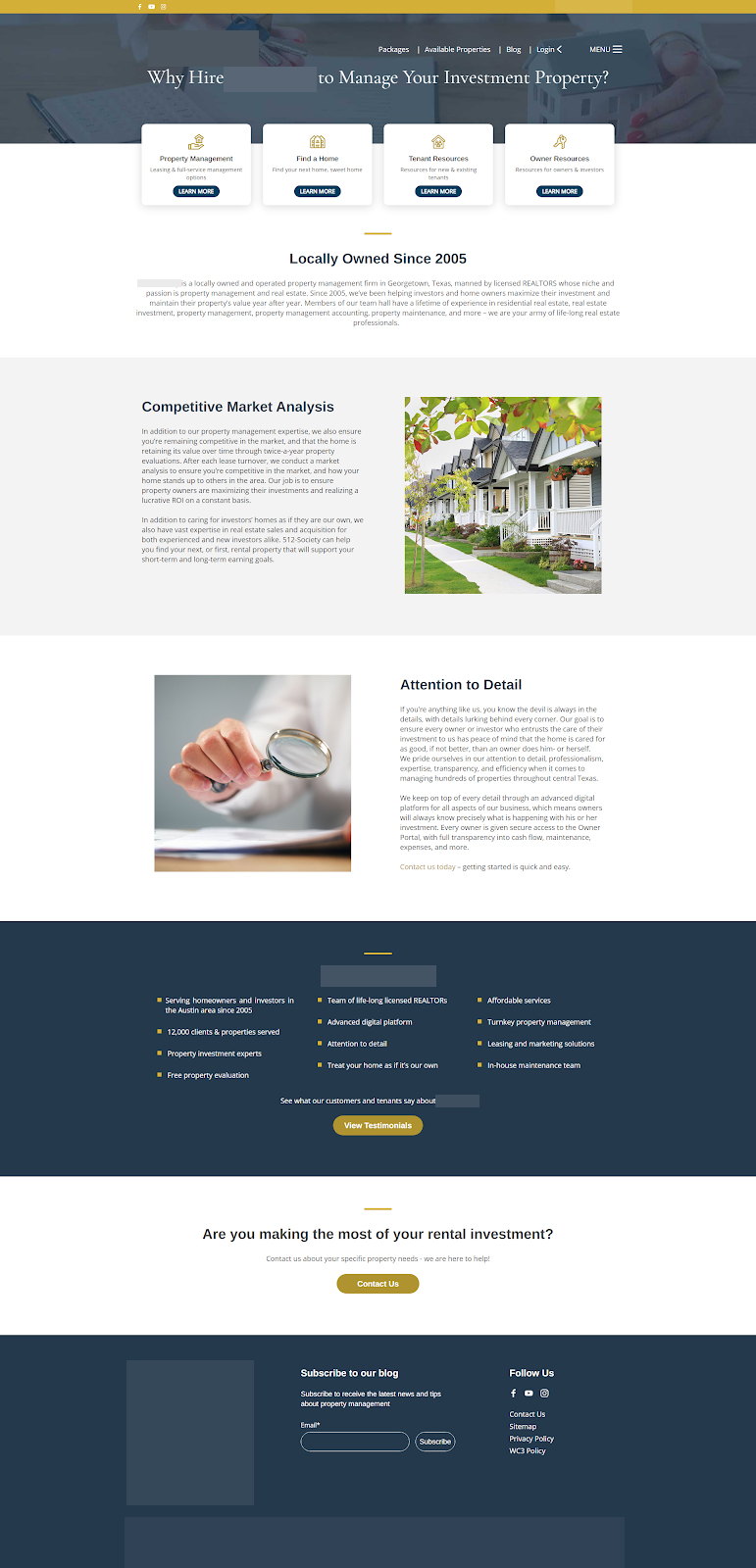
Now with the headings, both consumers and search engine bots can quickly identify that this investor is locally owned, offers a competitive market analysis, and pays close attention to detail.
Sometimes it also helps to break up important paragraphs into easily digestible sections of content with subheadings clearly labeling each section. Take this wheelchair product description, for example. It lists every detail within this long and blocky paragraph, making it difficult to locate the most pertinent details.
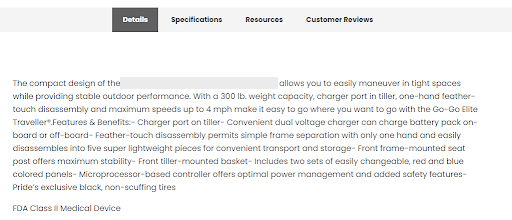
To fix this issue, our SEO team broke this content up into several important categories using a heading, subheading, and bullet points:
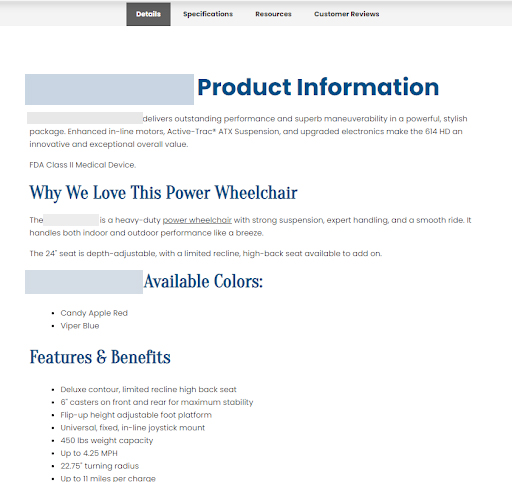
With these edits, you now immediately know what the product is called, lists its unique selling proposition right away, and lists secondary features and benefits in a more accessible format.
Sometimes, even broken-up paragraphs need distinguishing subheads. This lawyer does a good job of breaking up this article into sections, but again, it’s tough to know exactly what the article is talking about without reading each bit.
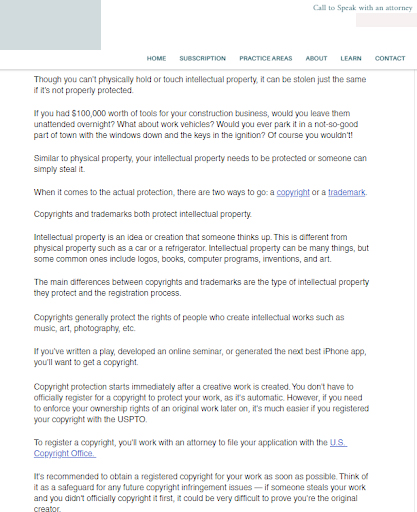
To give this article an SEO boost, our team broke up the content with a heading, grouping some of the paragraphs together under specific subheads, and breaking down specific data with bullet points.
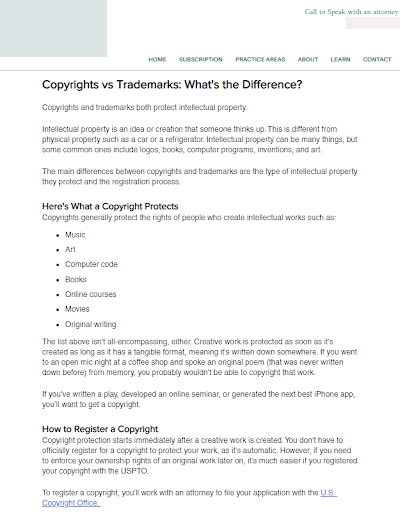
Your website’s copy is the key to ranking in local searches. While you should ultimately write to provide the best content possible for users, search engines close pay attention to the copy. Search engines love structure – different parts of a webpage, such as headings and subheadings, are weighted more heavily for ranking than regular text.
Content on your website should be broken up into easily digestible sections using the following:
- Headings to identify what the page is talking about
- Subheadings to identify specific topics
- Bullet Points to break up longer lists
- Images to break up long pieces of text
Once you have your content broken down into more easily ingestible sections, you need to incorporate industry-related keywords and phrases that get you noticed in search engines – more on that below.
4. Keyword Research & Implementation
Keywords are what users type into search engines to find the content they’re looking for. They’re specific words or phrases that are important to include within your web content – including keywords means that search engines have strong signals about what exactly you want to rank for, thus making it easier for potential customers to find you.
As a small business owner, you’re aiming to select words and phrases that people use to discover your type of business in a specific area.
To figure out which keywords are best for your business, I highly advise using a keyword research tool, which helps sort through lots of complicated data. Google Ads has a keyword search tool called Keyword Planner. There are also several other prominent online keyword research tools like SEMrush or Ahrefs.
All of these tools provide in-depth data about keywords, such as:
- Search volume: how often that keyword is searched for on a monthly basis
- Competition Level: how difficult it will be to make your content stand out against others using the same keyword
- Search Engine Results Pages (SERP): a preview of top-ranking websites when you type in this keyword. It can help you gauge how you’d stack up against the competition. For example, if you’re a small local doctor and the only websites ranking on the first page are WebMD, the New York Times, Healthline, and Washington Post, that keyword is probably too difficult to rank for.
Here are the stats about “funeral home” as a keyword:
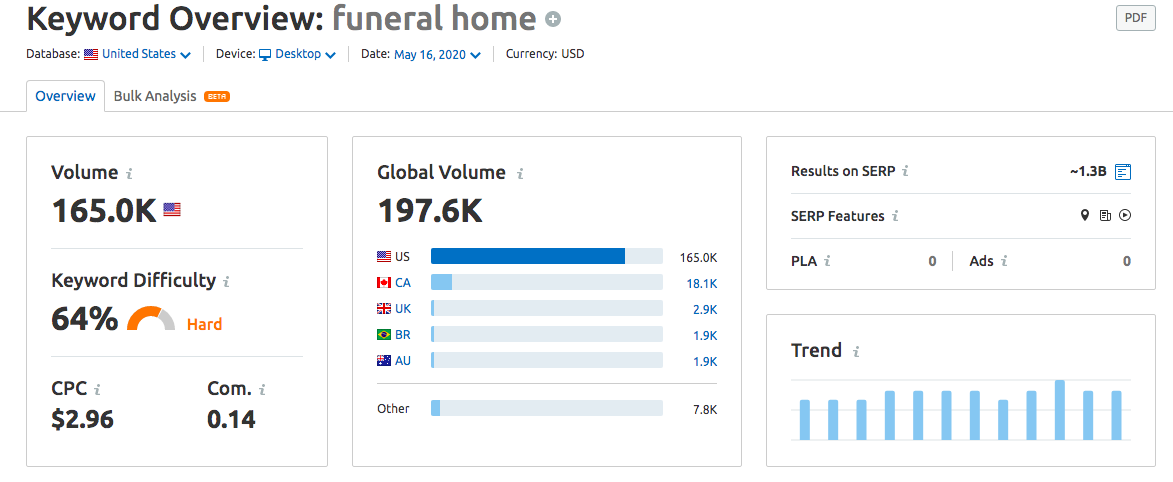
They also provide you with the keyword’s variations, questions related to that keyword (which can be a huge help when outlining content!), and related keywords, along with their respective monthly search volumes:
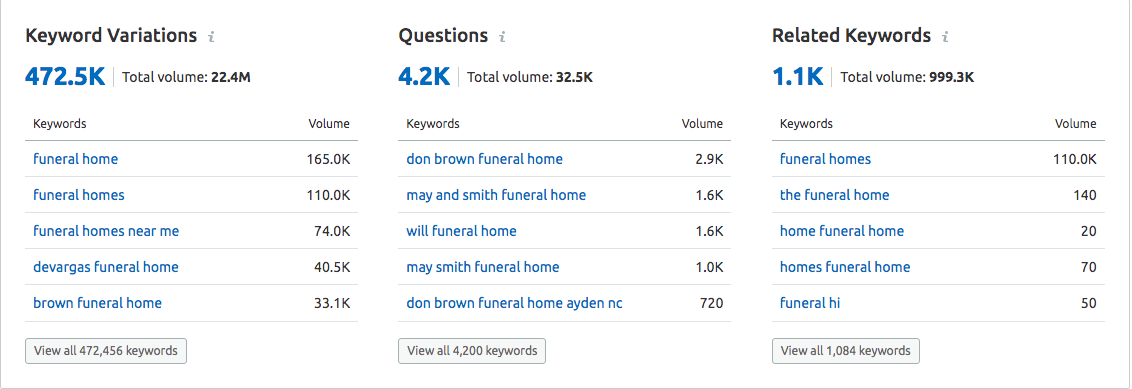
If you operate in one town or region, make sure you include local data about your region, city, or state in your keyword research. Some variations of what localized keywords may look like:
- Funeral home Clearwater, FL
- Funeral home in Clearwater
- Clearwater funeral home
If trying to navigate a keyword research tool seems off-putting, you can start by just Google searching and checking out the search engine results page (SERP).
If you Google search “funeral home near me”, you can see all of the phrases relevant to your area and more!
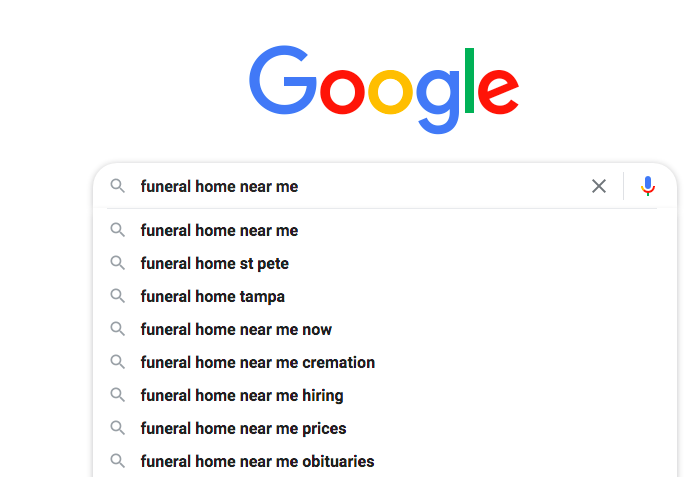
You can focus on these keywords, but be warned: they’re listed immediately because of how high their search volume is, meaning the competition level to rank for these keywords is high. In order to see results more quickly, start your efforts with less competitive keywords.
In addition, you can also go to the “People ask box”, which is on the first page of Google. This will list questions related to your search. These are the results for “funeral home near me”:
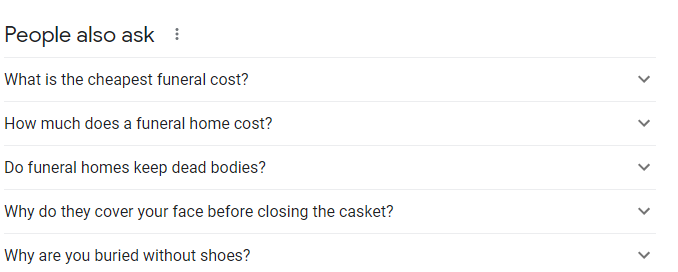
These are the questions people are asking in my area relating to funeral homes, and these questions are a perfect source of topics to start an SEO blog – more on that below.
Writing a Keyword-Driven SEO Blog
Once you’ve included some keywords into website elements such as the headlines and subheadlines, start writing a useful SEO-keyword-driven blog! Blogs optimized for SEO can help improve your site’s overall ranking because they help you build authority on that topic.
For example, a dental website with an entire blog section dedicated to answering common questions about teeth whitening methods will be more attractive to a search engine compared to another dental site with zero content on that topic.
To discover what topics your consumers would be interested in reading, just try to put yourself in your customers’ shoes. Become the local authority and answer common questions your customers have, speaking to them as if they don’t know anything about the subject.
For example, let’s say you’re a local dentist and you want to get in more patients for teeth whitening. You’d want to build up content on your blog about this topic. Based on keyword research, you’d find that people are searching for:
- How long does teeth whitening last?
- Is professional teeth whitening worth it?
- Professional vs at-home teeth whitening
- How much does teeth whitening cost?
- What is the teeth whitening process?
- Does teeth whitening hurt?
All of those questions can be individual topics for blog posts! This way, you’re meeting customers exactly where they are and providing high-quality content to meet them where they’re searching.
5. Optimizing Website URLs
URL stands for Uniform Resource Locator (technical stuff blah blah)…basically, it’s what you enter into the address bar to get a particular website to pop up.
URLs can be changed to be user-friendly and optimized for search engines so they can easily understand and better categorize them.
There is a good chance your website probably uses WordPress, one of the most popular free website creation and hosting platforms, better known as Content Management Systems (CMS). Here’s a helpful guide on how to edit the address in WordPress.
To start off, every page on your website should follow the same structure and use similar slugs, which is the part of a URL that identifies a specific website page that regular ole’ humans can read. It’s at the end of the URL and explains the page’s content.
So, if you have multiple service pages, create a main category for services, and have each URL slug contain /services/, followed by what the specific service is.
For example, a dentist could their services broken into:
- com/services/porcelain-veneers/
- com/services/teeth-whitening/
- com/services/cleaning/
In addition, try to keep URLs as short as possible; the URL should not run across the entire browser, and it shouldn’t be the entire headline of the page. Keep them short, sweet, and throw in a keyword!
For example, if you have a blog post entitled “10 Best Tips to Keep Your Braces Clean!”, the URL shouldn’t be “dentist.com/blog/10-best-tips-to-keep-braces-clean/”. Just keep it short, like “dentist.com/blog/tips-for-clean-braces/”.
Also, if your website defaults to URLs that include the date in them or a random string of numbers (it happens sometimes), remove those! It doesn’t provide any value to users or search engines.
The huge advantage of optimizing URLs is the ability to incorporate particular keywords that you’re trying to rank your website for. It’s one of the best SEO practices available to get your website ranked.
So if you’re trying to rank for the keyword phrase “dental cleaning”, you can adjust your slug to include this phrase, whether it’s on a service page or a blog post.
6. Optimizing Your Website’s Metadata to Rank Higher
Now we’re starting to get to the more technical side of SEO…but don’t worry! You don’t need to be a computer programmer to make these edits. Most website building softwares have features that let you easily access this data.
All the edits we’ve made up until this point are content edits, which are important for users and search engine bots to identify and select your website during a keyword search. Metadata (data that summarizes and describes information) edits drastically improve click-thru rates (CTR) of your website listing.
There are two main types of metadata you need to pay attention to:
- Title Tags & Meta Descriptions: The title and description that appear in search engine results. This is the first thing a user sees related to your website, so it’s important to optimize them!
- Alt Text: Back-end code that describes each image on a website.
Title Tags
Metadata is written in HTML (Hypertext Markup Language) format, which is the language depicting how webpages are displayed in the web browser. Title tags are HTML elements that specify to the search engine what the title of the webpage is to see if it matches a user’s search.
A website page’s title tag appears to the searcher as the clickable headline for the user in the search results.

For bots, A page’s title tag is displayed as part of the HTML search snippet in a search engine results page (SERP). You can access it in WordPress with this handy tool.
A typical HTML title example is located here:
<head><title>Example Title</title></head>
A page’s title tag will be within the <head> section of the page’s HTML code. Here is PostcardMania’s:
<title>PostcardMania: Postcard Printing & Direct Mail</title><meta name=”description”content=”lets you precisely target the most qualified prospects with postcard mailings and optional matching ads on Google, Facebook & Instagram.”>
Keep Meta Titles Within 60 Characters
It’s a general rule in SEO to keep all text accessible and direct, and title tags follow the same standard. You should be able to read about 90% of your title so it can show in the SERPs. Most browsers are able to display the first 50-60 characters of a title tag, so try and keep it within this range. Use this tool to check!
Use Keywords, But Don’t Overdo It!
When including keywords in your title tags, try not to overstuff your titles with keywords, as this is actually counterproductive and may hurt your overall ranking for those keywords. An example of keyword stuffing in a title tag:
PostcardMania: Postcard Printing & Direct Mail | Cheap Postcards | Best Direct Mail Service | Postcard Marketing
Make Sure Each Page Has a Unique Title
Lastly, give every webpage a unique title. Here’s an example of a previous client’s webpage title that is NOT unique and was hurting their local SEO ranking.
Calvo Insurance Homepage – Calvo Insurance
https://www.calvoinsurance.com/homepage
You never need the words “Home” or “Homepage” anywhere in your title, as this is an extremely vague and commonly used phrase that both users and bots alike will skip right over. Instead, include more specific data about the company, like this:
Independent Insurance Agency | Hallandale, FL | Calvo Insurance
https://www.calvoinsurance.com
With this edit, users and search engines now can recognize exactly what kind of insurance agency they are and where they’re located – which significantly helps their local SEO ranking.
While it may seem difficult to come up with an entirely new and unique title tag for every page, use your company’s branding, location, and selected keyword to stand out! For your website, it’s best to include your target keyword at the front of a meta title. An optimized meta title structure for a local HVAC company could be [Keyword] | [Service] | [Location] | [Business Name], for example:
(Meta Title) HVAC Tune-Up | HVAC Technician | Clearwater, FL | HVAC Company Name
(HTML Title) https://www.HVACcompanyName.com/services/tune-up
If you run an ecommerce business and services company with products, it could be [Product Name] | [Product Category] | [Business Name]
Meta Descriptions
Meta Descriptions are an HTML element that summarizes the contents of your page, located under the clickable title.

In the HTML code, you can find it here:
<title>PostcardMania: Postcard Printing & Direct Mail</title><meta name=”description”content=”lets you precisely target the most qualified prospects with postcard mailings and optional matching ads on Google, Facebook & Instagram.”>
These can obviously be longer than title tags, but similarly don’t make them too long. Try to keep them under 155 characters in total.
Depending on the goal of that webpage, it’s a smart online business practice to include a Call To Action (CTA) at the end of the meta description. Some examples could be ”Learn more here, Read it here, etc”. While meta descriptions do give Google some context clues as to what your web page is about, the meta description acts as sales copy and should entice users into your website.

Your meta description should also include the central keyword that you’re attempting to get ranked for. If a search matches a part of the meta description text, the search engine will like it more and be pushed to use it and highlight the keywords. This is a search for “postcard mailings”, where the keywords are highlighted in the meta description:

You’ll notice that “postcard mailings” isn’t an exact phrase in our meta description. Search engine bots have the ability to pick up on variations of keywords, so don’t worry too much about forcing them in and having the description read awkwardly!
Like title tags, your meta description should be unique to every page and not have any duplicates. Even if you have hundreds of pages like PostcardMania does, I still recommend writing meta descriptions – the more info you can feed search engine bots, the better!
Alt Text
Alt text is necessary to be compliant with the ADA (American’s with Disabilities Act), so it isn’t just necessary for SEO, it’s required. It gives SEO a slight boost because don’t have eyes, they need help deciphering what your website images depict. They’re used within HTML code to describe what an image looks like and its function to the search engine bots. An example of an image and its accompanying alt text:

<img src=”HVAC_Marketing_Postcard.jpg” alt=”HVAC Marketing Case Study Postcard Example”>
The best alt text is efficiently describing the image but doesn’t attempt to overstuff keywords. Think of it this way — alt images aren’t just for bots, they also provide accessibility to your website for the visually impaired. They should be able to read the alt text and get an accurate depiction of what the image is or looks like.
Like all metadata, make each description as short, direct, and unique as possible.
Remember every image or visual element needs alt text, including form elements that aren’t actual pictures like submission buttons and website headers.
And that, my dear friends, is your essential localized SEO element checklist! While performing website edits, I see small business owners make all of the common mistakes below. I mentioned many of these already, but included them again as a refresher:
- Not writing unique title tags
- Not writing unique meta descriptions
- Not including headers through each page (i.e. just having one main headline and a wall of text with zero additional headlines)
- Not breaking up walls of text (create white space! Don’t cluster more than a few sentences together. Take advantage of bulleted lists, numbered lists, photos, etc. as these are easier for search engine bots to read)
- Not including your location throughout your website when you’re a local business
- Not having location landing pages if you serve multiple cities or states
- Not having clear and consistent contact information
- Listing your address differently on multiple citation websites (using #123, suite 123, and ste. 123 on different websites).
- Not correcting old business phone numbers, addresses, or names on citations websites
Feeling overwhelmed yet?
I know, it’s a LOT and these are just several of the first steps your business needs to take. Fully optimizing your business for SEO has so many additional factors and is an ongoing process.
While we can’t teach you everything you need to know about SEO with one guide, we can give you a solid place to start.
I understand that many small business owners don’t see the value in taking all of this time to do it on their own. That’s why PostcardMania offers an affordable Local SEO Service to help you with all of the items listed above and way more!
If you have any questions, feel free to contact one of our marketing experts or call us at 1-800-628-1804.
Or, you can always email me directly at joy.gendusa@postcardmania.com.
Best,
Joy
